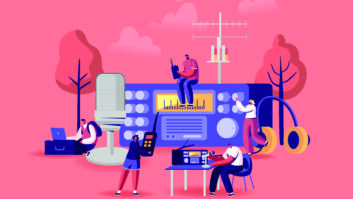Radio World’s “Guest Commentaries” section provides a platform for industry thought leaders and other readers to share their perspective on radio news, technological trends and more. If you’d like to contribute a commentary, or reply to an already published piece, send a submission to [email protected].
Below is perspective from Ruxandra Obreja, consortium chairman of Digital Radio Mondiale (DRM), in response to the commentary “Why Reviving Shortwave is a Non-Starter.”
While there is no doubt that shortwave has been in decline over the past two to three decades, the idea that the BBC and others have reintroduced shortwave now, during the Ukraine crisis, just as a PR exercise and as a shrewd move to blunt the threat of getting reduced funding, seems a bit exaggerated. If nothing else, this would be quite an expensive PR maneuver wasting a chunk of the taxpayers’ money (about $5 million).
The authors of the article make a few assumptions which are only partly true: there are very few shortwave listeners, as most have migrated to internet and mobiles, the popular, paid, alternative sources. This is only partly true, as is the fact that there are still many shortwave hobbyists. But we should not discard those 30-40 million listeners the BBC World Service alone still has in Africa, for example.
The “revival” of shortwave would be an exaggeration, while a re-examination of a technology widely seen as a relic of the Cold War in Europe and overdue for replacement in favor of the ubiquitous mobiles, digital FM, and internet radio is possibly nearer the truth.
Taking a wider view, we can state that shortwave never disappeared in most of the world. However, in Europe, with its dense population and excellent infrastructure, the technique is considered power-hungry and unnecessary in times of peace and stability. Remember those times?
In its digital (DRM) reincarnation, the shortwave transmitters are not limited to the distorted, crackly broadcasts of the past. Transmitters are factory-fitted for Digital Radio Mondiale: the only digitization technique developed for shortwave. DRM shortwave gives broadcasters the possibility to broadcast crystal-clear FM quality stereo sound, and even deliver images and videos simultaneously. This can provide enormous benefits when broadcasting to displaced people or populations under censorship using not an antiquated technology but a 21st century one.
[Related: “A Response to Why Reviving Shortwave Is a Non-Starter”]
So, while many see shortwave as “uncool”, it’s just because it’s relatively simple and robust. Shortwave is simpler than comparable digital TV or new telecom-based services. In either analog or digital mode, shortwave works across long distances since it uses low frequency radio waves that reflect from the upper atmosphere to deliver services beyond the horizon. New or upgraded digital transmitters can deliver either audio, data or a mix of multi-language content. Most importantly, shortwave broadcasts are also free-to-air, one-to-many, and listeners are untraceable. The signal can come from another country or continent, remote from zones of conflict or emergency, unlike TV or mobile signals, which are much more local. By the way, I have not seen many mobile and TV towers still standing in the Ukrainian cities and villages under attack. And since shortwave transmissions use low frequencies, the signal propagates through buildings and other obstacles much better than higher frequencies, thereby reaching into homes and basements. Today, analog receivers are still plentiful, as are digital SDR solutions — the currently affordable phone and tablet dongles provide other ways of receiving shortwave in both analog and DRM. And technology already exists for affordable DRM receivers: manufacturers are simply awaiting bulk orders.
If one of the many unforeseen results of the current crisis in Ukraine is to encourage a focus on shortwave, let us not forget that what seems like an old technology is just a simpler technology. Digital shortwave broadcasting exists, is already deployed and is increasing in reach. Receivers are the key and must be made widely available with both digital and analog modes. There will be a cost, but this is surely negligible compared to the human and material costs of a terrible war carried out mainly along 20th century terrible practices.







